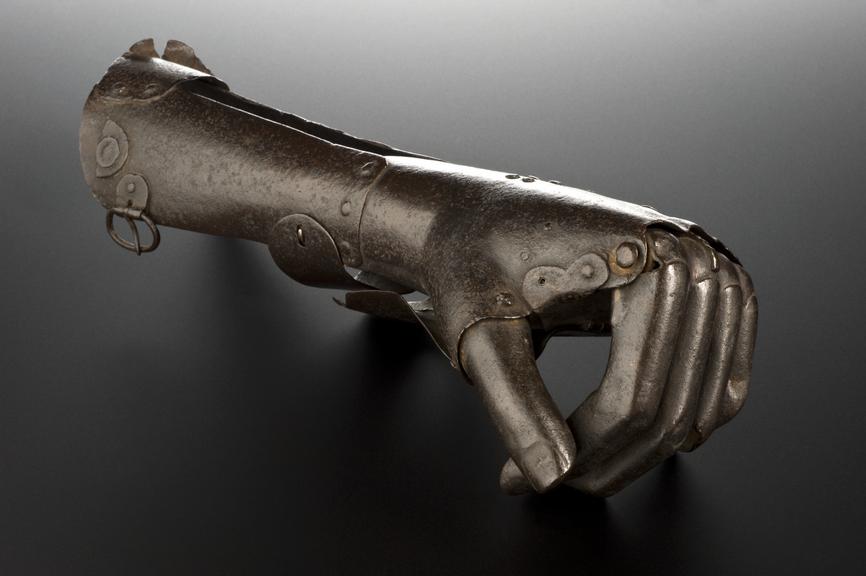A historical artifact from the Science Museum in London, a prosthetic arm from 1560–1600

The Science Museum in London houses a remarkable array of historical artifacts, but few are as fascinating and evocative as the prosthetic arm dating from between 1560 and 1600. This ancient prosthetic is not merely a relic of medical history; it is a testament to the ingenuity and resilience of humanity in the face of physical adversity. The arm provides a unique window into the technological advancements, craftsmanship, and social attitudes towards disability during the Renaissance period.
Crafted in an era when medical science was still in its nascent stages, this prosthetic arm is a marvel of early bioengineering. The design and construction of the arm reflect a sophisticated understanding of mechanics and human anatomy. Made from materials such as iron, leather, and wood, the prosthetic was likely custom-made for its wearer, indicating a personalized approach to medical care. The intricate joints and mechanisms allowed for a range of movements, demonstrating that functionality was a primary concern even centuries ago.
The Renaissance was a period of significant advancements in art, science, and technology. This prosthetic arm exemplifies the innovative spirit of the time. The craftsmanship involved in creating such a device was extraordinary, considering the limited tools and knowledge available. Artisans would have painstakingly shaped and assembled the components, ensuring that the prosthetic was both durable and as comfortable as possible. The arm’s design might have included adjustable straps for a secure fit and movable fingers to grasp objects, showing a remarkable level of sophistication for its time.

The existence of this prosthetic arm also sheds light on the societal attitudes towards disability during the 16th century. Unlike earlier periods, when individuals with disabilities were often marginalized, the Renaissance saw a growing recognition of their needs and potential contributions to society. The creation of prosthetics like this arm indicates an effort to restore functionality and improve the quality of life for those with physical impairments. This artifact suggests that individuals who lost limbs due to injury or illness were not condemned to a life of helplessness; instead, there was a concerted effort to reintegrate them into society.
Moreover, the prosthetic arm from this period also points to the status and wealth of its wearer. Given the complexity and cost of producing such a device, it is likely that the individual who used it belonged to the upper echelons of society. This aspect highlights the intersection of medicine, technology, and social class. Wealthy individuals could afford customized medical solutions, which allowed them to maintain their social and economic roles despite their disabilities.
The Science Museum in London has preserved this prosthetic arm as part of its extensive collection of medical artifacts, providing invaluable insights into the history of prosthetics and medical care. The display of this arm allows visitors to appreciate the historical context of disability and the evolution of medical technology. It stands as a symbol of human resilience and the continuous quest for improvement in the face of physical challenges.

Full fiew, graduated matt black perspex background.
Full fiew, graduated matt black perspex background.
The story of this prosthetic arm is further enriched by considering the broader historical and cultural context of the Renaissance. This period was marked by a flourishing of arts and sciences, driven by a renewed interest in classical knowledge and an optimistic view of human potential. In this environment, the development of prosthetics was not just a medical advancement but also a reflection of the Renaissance ideals of innovation, individual dignity, and the betterment of human life.
In conclusion, the prosthetic arm dating from 1560 to 1600 at the Science Museum in London is more than an ancient medical device; it is a profound historical artifact that encapsulates the ingenuity and humanism of the Renaissance period. Through its sophisticated design and construction, the arm demonstrates the advanced understanding of mechanics and anatomy of the time. It also reflects the evolving social attitudes towards disability and the efforts to reintegrate individuals with impairments into society. Preserved and displayed at the Science Museum, this prosthetic arm continues to inspire and educate, highlighting the enduring human spirit and the relentless pursuit of technological and medical advancement.